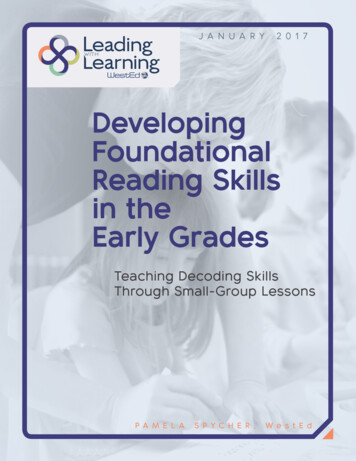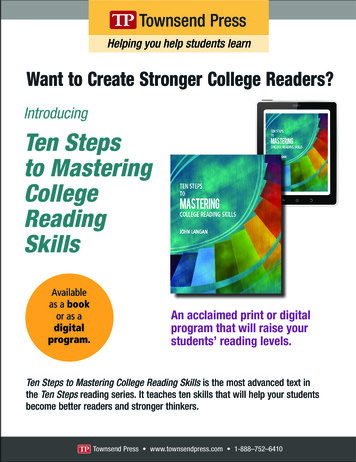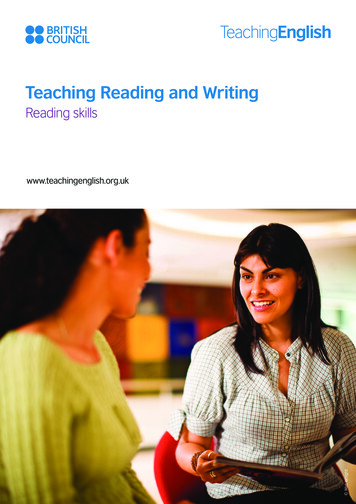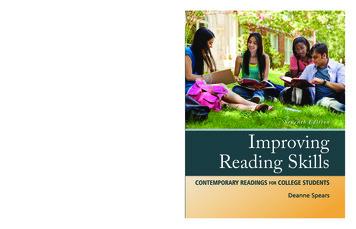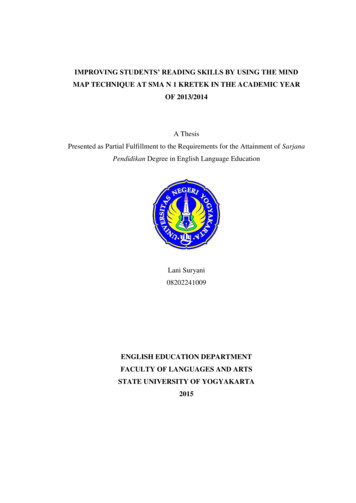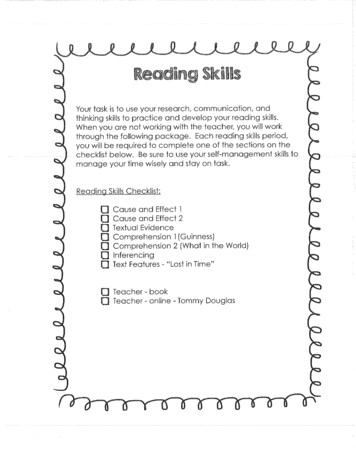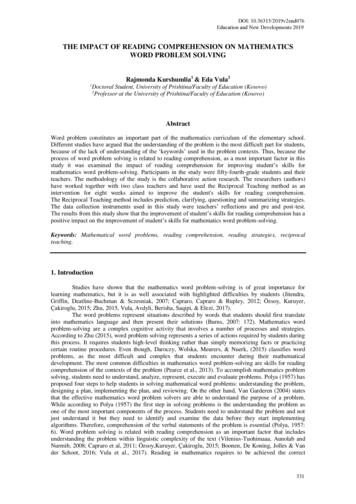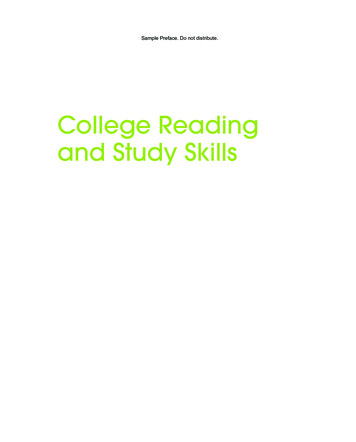
Transcription
A01 MCWH8067 14 AIE FM.indd Page 1 07/12/18 1:22 PM f-0037/207/OHL00015/9780134996295 MCWHORTER/MCWHORTER COLLEGE READING AND STUDY SKILLSSample Preface. Do not distribute.College Readingand Study Skills
A01 MCWH8067 14 AIE FM.indd Page 2 07/12/18 1:22 PM f-0037/207/OHL00015/9780134996295 MCWHORTER/MCWHORTER COLLEGE READING AND STUDY SKILLSSample Preface. Do not distribute.
A01 MCWH8067 14 AIE FM.indd Page 3 07/12/18 1:22 PM f-0037/207/OHL00015/9780134996295 MCWHORTER/MCWHORTER COLLEGE READING AND STUDY SKILLSSample Preface. Do not distribute.College Readingand Study SkillsFourteenth EditionKATHLEEN T. McWHORTERNiagara County Community CollegeBRETTE McWHORTER SEMBER
A01 MCWH8067 14 AIE FM.indd Page 4 07/12/18 1:22 PM f-0037/207/OHL00015/9780134996295 MCWHORTER/MCWHORTER COLLEGE READING AND STUDY SKILLSSample Preface. Do not distribute.Executive Portfolio Manager: Chris HoagPortfolio Manager: Matt SummersContent Producer: Katharine GlynnManaging Producer: Alex BrownContent Developer: Janice WigginsPortfolio Manager Assistant: Andres MaldonadoProduct Marketer: Erin RushField Marketer: Michael CoonsContent Producer Manager: Ken VolcjakContent Development Manager: Joanne DauskewiczArt/Designer: iEnergizer Aptara , Ltd.Course Producer: Jessica KajkowskiFull-Service Project Manager: iEnergizer Aptara , Ltd.Compositor: iEnergizer Aptara , Ltd.Printer/Binder: LSC Communications, Inc.Cover Printer: Phoenix Color/HagerstownCover Design: Wing Ngan, Ink design, inc.Cover Art Direction: Cate Rickard BarrAcknowledgements of third party content appear within the text or on pages 459–462,which constitutes an extension of this copyright page.Copyright 2020, 2017, 2013 by Pearson Education, Inc. 221 River Street, Hoboken,NJ 07030 or its affiliates. All Rights Reserved. Printed in the United States of America.This publication is protected by copyright, and permission should be obtained from thepublisher prior to any prohibited reproduction, storage in a retrieval system, ortransmission in any form or by any means, electronic, mechanical, photocopying,recording, or otherwise. For information regarding permissions, request forms, and theappropriate contacts within the Pearson Education Global Rights & PermissionsDepartment, please visit www.pearsoned.com/permissions/.PEARSON, ALWAYS LEARNING, and MYLAB READING are exclusive trademarks owned byPearson Education, Inc. or its affiliates in the United States and/or other countries.Unless otherwise indicated herein, any third-party trademarks that may appear in thiswork are the property of their respective owners and any references to third-partytrademarks, logos, or other trade dress are for demonstrative or descriptive purposes only.Such references are not intended to imply any sponsorship, endorsement, authorization,or promotion of Pearson’s products by the owners of such marks, or any relationshipbetween the owner and Pearson Education, Inc., or its affiliates, authors, licensees, ordistributors.Library of Congress Cataloging-in-Publication DataNames: McWhorter, Kathleen T., author.Title: College reading and study skills / Kathleen T. McWhorter, NiagaraCounty Community College, Brette McWhorter Sember.Description: Fourteenth Edition. New York : Pearson, [2019]Identifiers: LCCN 2018051785 ISBN 9780135228067 (Annotated Instructor’sEdition) ISBN 0135228069 (Annotated Instructor’s Edition) ISBN9780134996295 (Student Edition) ISBN 0134996291 (Student Edition) ISBN9780135227084 (Loose-Leaf Edition) ISBN 0135227089 (Loose-Leaf Edition)Subjects: LCSH: Reading (Higher education) Study skills.Classification: LCC LB2395.3 .M386 2019 DDC 428.4071/2—dc23 LC recordavailable at https://lccn.loc.gov/2018051785MyLab Access Code CardISBN-10:0-13-530506-3ISBN-13: 978-0-13-530506-5Student EditionISBN-10:0-13-499629-1ISBN-13: 978-0-13-499629-5Loose-Leaf EditionISBN 10:0-13-522708-9ISBN 13: 978-0-13-522708-4
A01 MCWH8067 14 AIE FM.indd Page 5 07/12/18 1:22 PM f-0037/207/OHL00015/9780134996295 MCWHORTER/MCWHORTER COLLEGE READING AND STUDY SKILLSSample Preface. Do not distribute.BRIEF CONTENTSDetailed ContentsPreface xiiiPart Four: Thinking Criticallyas You Read 262viiSUCCESS 6. Build Your Information LiteracyPart One: Building a Foundation forAcademic Success 2Chapter 10SUCCESS 1. Read and Learn Online 2Evaluating the Author’sMessage 266Chapter 11Evaluating Authors’Techniques 299WORKSHOPS2. Manage Your Electronic LifeChapter 1First Steps to AcademicSuccess 10Chapter 2Taking Notes in ClassChapter 3Communicating in theClassroom 626WORKSHOP262Part Five: Strategies for AcademicAchievement 31642SUCCESS 7. Think Critically About CollegeWORKSHOPSCourse Content 3168. Manage Stress 320Part Two: Using CollegeTextbooks 76Chapter 12Reading and Thinking Critically inAcademic Disciplines 324SUCCESS 3. Work with New Course Formats:Online, Hybrid, and FlippedCourses 764. Strengthen Your Concentration 80Chapter 13Preparing for ExamsChapter 14Taking ExamsChapter 4Identify and Organize What toLearn 84Part Six: Thematic ReadingsChapter 5Learning and MemoryWORKSHOPS125Part Three: Essential ReadingSkills 144SUCCESS 5. Improve Your Reading Rate andWORKSHOPSFlexibility 144Copyright 2020 by Pearson Education, Inc.and Recognize Fake NewsChapter 6Active Reading Strategies147Chapter 7Expanding Your VocabularyChapter 8Understanding Paragraphs206Chapter 9Following Thought Patterns232178347366388Theme ANon-Traditional AddictionsTheme BDiscriminationTheme CControversies in Science389405421Part Seven: Sample TextbookChapter: Textbook Readingand Writing 436Text Credits 459Index 463v
A01 MCWH8067 14 AIE FM.indd Page 6 07/12/18 1:22 PM f-0037/207/OHL00015/9780134996295 MCWHORTER/MCWHORTER COLLEGE READING AND STUDY SKILLSSample Preface. Do not distribute.
A01 MCWH8067 14 AIE FM.indd Page 7 07/12/18 1:22 PM f-0037/207/OHL00015/9780134996295 MCWHORTER/MCWHORTER COLLEGE READING AND STUDY SKILLSSample Preface. Do not distribute.DETAILED CONTENTSPrefacexiiiPart One: Building a Foundation for Academic Success2SUCCESS 1. Read and Learn Online 2WORKSHOPSChapter 1Chapter 2Copyright 2020 by Pearson Education, Inc.Chapter 32. Manage Your Electronic Life6First Steps to Academic Success10Establishing Goals and Managing Your Valuable Time 11Analyzing Your Learning Style 20Understanding Your Instructors’ Teaching Styles 26Meeting Your Instructors’ Expectations 28Developing Active Learning Strategies 31Thinking Critically 33 Using College Textbooks: Keeping Track of and Analyzing ReadingAssignments 37Self-Test Summary 38Applying Your Skills: Using the Sample Textbook Chapter 39 Analyzing a Study Situation Working on Collaborative Projects 40Quick Quiz 41Taking Notes in Class4042Sharpening Your Listening Skills 43Preparing for a Class Lecture 43How to Take Lecture Notes 44How to Edit Your Notes 51How to Study Your Notes 54 Using College Textbooks: Taking Notes on Textbook Readings 57Self-Test Summary 59Applying Your Skills: Using the Sample Textbook Chapter 60 Analyzing a Study Situation Working on Collaborative Projects 60Quick Quiz 61Communicating in the Classroom6062Listening Critically 63Asking and Answering Questions 64Participating in Class Discussions 65Working on Collaborative Activities 67Making Oral Presentations 68Communicating with Your Professors 70 Using College Textbooks: Preparing for Class Discussions 71Self-Test Summary 72Applying Your Skills: Using the Sample Textbook Chapter 73 Analyzing a Study Situation Working on Collaborative Projects 74Quick Quiz 7573vii
A01 MCWH8067 14 AIE FM.indd Page 8 07/12/18 1:22 PM f-0037viii Detailed Contents/207/OHL00015/9780134996295 MCWHORTER/MCWHORTER COLLEGE READING AND STUDY SKILLSSample Preface. Do not distribute.Part Two: Using College Textbooks76SUCCESS 3. Work with New Course Formats: Online, Hybrid, and Flipped Courses 76WORKSHOPSChapter 4Chapter 54. Strengthen Your Concentration80Identify and Organize What to Learn84Paraphrasing 85Highlighting 88Marking a Textbook 95Organizing by Outlining 98Summarizing: Condensing Ideas 102Mapping: A Visual Means of Organizing Ideas 109Avoiding Plagiarism 116 Using College Textbooks: Knowing What Is Important and IdentifyingSupporting Details 118Self-Test Summary 122Applying Your Skills: Using the Sample Textbook Chapter 123 Analyzing a Study Situation Working on Collaborative Projects 123Quick Quiz 124Learning and Memory123125Forgetting 126An Overview of the Learning and Memory Process 127Learning Strategies 130Review 135 Using College Textbooks: Deciding What to Learn 138Self-Test Summary 140Applying Your Skills: Using the Sample Textbook Chapter 140 Analyzing a Study Situation Working on Collaborative Projects 141Quick Quiz 142Part Three: Essential Reading Skills140144SUCCESS 5. Improve Your Reading Rate and Flexibility 144WORKSHOPChapter 6Active Reading Strategies147Previewing and Predicting Before Reading 148Discovering What You Already Know 155Defining Your Purposes for Reading 155Checking Your Comprehension as You Read 158Strengthening Your Comprehension of Text 161Reviewing After Reading 163Strengthening Your Comprehension of Visual Aids 164A Classic System for Active Reading: SQ3R 168 Using College Textbooks: Reading Difficult Textbooks 173Self-Test Summary 174Applying Your Skills: Using the Sample Textbook Chapter 175 Analyzing a Study Situation Working on Collaborative Projects 176Quick Quiz 177175
A01 MCWH8067 14 AIE FM.indd Page 9 07/12/18 1:22 PM f-0037/207/OHL00015/9780134996295 MCWHORTER/MCWHORTER COLLEGE READING AND STUDY SKILLSSample Preface. Do not distribute.Chapter 7Chapter 8Chapter 9Expanding Your Vocabulary178General Approaches to Vocabulary Expansion 179A Strategy for Learning Unfamiliar Words 181Using Context Clues 181Analyzing Word Parts 188Using Reference Sources 195Learning Specialized Terminology 198Systems for Learning Vocabulary 200 Using College Textbooks: Locating Word Meanings 201Self-Test Summary 203Applying Your Skills: Using the Sample Textbook Chapter 204 Analyzing a Study Situation Working on Collaborative Projects 204Quick Quiz 205Understanding ParagraphsThree Essential Elements of a Paragraph 207How to Identify the Topic 208How to Find the Main Idea 212Where to Find the Topic Sentence 212Recognizing Details 216Transitions 222Unstated Main Ideas 223 Using College Textbooks: Locating Main Ideas 226Self-Test Summary 228Applying Your Skills: Using the Sample Textbook Chapter 229 Discussing the Chapter Analyzing a Study Situation 230 Working on Collaborative Projects 230Quick Quiz 231Following Thought Patterns204206229232The Organization of Textbook Chapters 233Types of Supporting Information 235Recognizing Organizational Patterns 240 Using College Textbooks: Identifying Patterns 257Self-Test Summary 259Applying Your Skills: Using the Sample Textbook Chapter 260 Analyzing a Study Situation Working on Collaborative Projects 260Quick Quiz 261Part Four: Thinking Critically as You ReadCopyright 2020 by Pearson Education, Inc.Detailed Contentsix262SUCCESS 6. Build Your Information Literacy and Recognize Fake News 262WORKSHOPChapter 10 Evaluating the Author’s Message266Making Inferences as You Read 267Evaluating Author and Source Credibility 270Evaluating Internet Sources 272Distinguishing Between Fact and Opinion 274Identifying the Author’s Purpose 276Being Alert for Bias 278Analyzing the Author’s Tone 280Analyzing Arguments 283260
A01 MCWH8067 14 AIE FM.indd Page 10 07/12/18 1:22 PM f-0037/207/OHL00015/9780134996295 MCWHORTER/MCWHORTER COLLEGE READING AND STUDY SKILLSSample Preface. Do not distribute.x Detailed ContentsEvaluating Data and Evidence 285Thinking Critically about Graphics 292 Using College Textbooks: Critical Thinking Questions 294Self-Test Summary 296Applying Your Skills: Using the Sample Textbook Chapter 297 Analyzing a Study Situation Working on Collaborative Projects 297Quick Quiz 298Chapter 11 Evaluating Authors’ Techniques297299Paying Attention to Connotative Language 300Examining Figurative Language 301Watching for Missing and Misleading Information 303Being Alert for Generalizations 305Examining the Author’s Assumptions 307Watching for Manipulative Language 308 Using College Textbooks: Using Critical Thinking Features 312Self-Test Summary 313Applying Your Skills: Using the Sample Textbook Chapter 314 Analyzing a Study Situation Working on Collaborative Projects 314Quick Quiz 315Part Five: Strategies for Academic Achievement314316SUCCESS 7. Think Critically About College Course Content 316WORKSHOPS8. Manage Stress320Chapter 12 Reading and Thinking Critically in Academic Disciplines 324Expanding Your Critical Thinking Abilities in Academic Disciplines 325What Are the Social Sciences? 331What Are the Life and Physical Sciences? 333What Is Mathematics? 336What Do Literature and the Humanities Study? 338What Are the Career Fields? 340 Using College Textbooks: Expanding Your Knowledge to OtherDisciplines 342Self-Test Summary 344Applying Your Skills: Using the Sample Textbook Chapter 345 Analyzing a Study Situation Working on Collaborative Projects 345Quick Quiz 346345Chapter 13 Preparing for Exams 347Organizing Your Study and Review 348Identifying What to Study 349Analyzing and Synthesizing Information 351Reviewing for Objective and Essay Exams 353Preparing for Self-Testing 356 Using College Textbooks: Using In-Chapter Self-Test Questions 360Self-Test Summary 362Applying Your Skills: Using the Sample Textbook Chapter 363 Analyzing a Study Situation Working on Collaborative Projects 364Quick Quiz 365363
A01 MCWH8067 14 AIE FM.indd Page 11 07/12/18 1:22 PM f-0037/207/OHL00015/9780134996295 MCWHORTER/MCWHORTER COLLEGE READING AND STUDY SKILLSSample Preface. Do not distribute.Detailed ContentsxiChapter 14 Taking Exams 366General Suggestions for Taking Exams 367Hints for Taking Objective Exams 369Hints for Taking Standardized Tests 374Hints for Taking Essay Exams 375Controlling Test Anxiety 381 Using College Textbooks: Using Headings to Create Practice Tests 383Self-Test Summary 384Applying Your Skills: Using the Sample Textbook Chapter 385 Analyzing a Study Situation Working on Collaborative Projects 386Quick Quiz 387385Part Six: Thematic Readings 388THEME A Non-Traditional Addictions 389A-1 The Netflix Addiction: Why Our Brains Keep Telling Us to Press Play 389A-2 Textbook Excerpt: Addictive Consumption 394A-3 A Food Addiction Has Defined My Entire Life. And It Is Slowly Killing Me 399Making Connections 403 What Do You Think? 403THEME BDiscrimination405THEME CControversies in ScienceB-1 Years After 9/11, Anti-Muslim Bigotry Is Worse Than Ever 405B-2 Textbook Excerpt: Racial Profiling and Biased Policing 409B-3 Singled Out: Are Unmarried People Discriminated Against? 415Making Connections 420 What Do You Think? 420421C-1 Shades of Grey in the Ethics of Designer Babies 421C-2 The Ocean’s Plastic Problem 425C-3 Textbook Excerpt: Some Possible Consequences of Global Warming 429Making Connections 435 What Do You Think? 435Part Seven: Sample Textbook Chapter: Textbook Reading and WritingPreparing for the LectureReading the Assignment436438Copyright 2020 by Pearson Education, Inc.Sociology Chapter Excerpt: Race and EthnicityReviewing the Reading Assignment439451Attending the Lecture and Participating in Class 451Writing About the ReadingTaking Quizzes 453Taking the ExamText Credits 459Index 463456452436
A01 MCWH8067 14 AIE FM.indd Page 12 07/12/18 1:22 PM f-0037/207/OHL00015/9780134996295 MCWHORTER/MCWHORTER COLLEGE READING AND STUDY SKILLSSample Preface. Do not distribute.
A01 MCWH8067 14 AIE FM.indd Page 13 07/12/18 1:22 PM f-0037/207/OHL00015/9780134996295 MCWHORTER/MCWHORTER COLLEGE READING AND STUDY SKILLSSample Preface. Do not distribute.PREFACEAcross thirteen editions, College Reading and Study Skills has demonstrated that reading andstudy skills are inseparable. A student must develop skills in each area in order to handlecollege work successfully. With this goal in mind, I have tried to provide complete coverageof both reading and study skills throughout and to show their relationship and interdependency. In doing so, my emphasis has been on direct instruction. My central aim is to teachreading and study skills through a how-to approach.NEW TO THE FOURTEENTH EDITIONThe new edition of College Reading and Study Skills features a stronger emphasis on discipline-specific college reading, expanded coverage of critical thinking, and revised andexpanded coverage of the digital age as it affects reading and study. The thematic reader(Part Six) features two new themes—the first on non-traditional addictions and the secondon discrimination.NEW CHAPTER ON DISCIPLINE-SPECIFIC READING SKILLS. Chapter 12, “Reading and Thinking Critically in Academic Disciplines,” focuses on five academic disciplines:social sciences and history, life and physical sciences, mathematics, literature and thehumanities, and career fields. The chapter begins by examining four types of critical thinking skills: decision-making, problem-solving, creative thinking, and scientific thinking,skills important to many academic disciplines. Because students need to learn to adapttheir reading skills to suit the nature of each discipline, the chapter identifies characteristics unique to each discipline and shows students how to adapt their reading skills toaccommodate these unique characteristics. Critical thinking skills are also presented foreach discipline.Copyright 2020 by Pearson Education, Inc.ENHANCED EMPHASIS ON CRITICAL THINKING SKILLS. Critical thinking skillsare now featured in every chapter. New “Thinking Critically” boxes have been added thatdemonstrate the relevance of critical thinking skills to chapter content. For example, inChapter 4, students are encouraged to evaluate the effectiveness of their highlighting; inChapter 6 they are encouraged to sharpen their critical thinking skills when previewing.Chapter 8 shows students the techniques used by writers to signal important informationin a paragraph.NEW COVERAGE OF DIGITAL READING SKILLS. Increasingly more reading, bothacademic and everyday, is done digitally; digital reading requires both adaptation of existing skills and development of new ones. Success Workshop 1, “Read and Learn Online,”explores the differences between print and digital reading. Because digital reading requiresnew and different skills, the workshop offers strategies for focusing and concentratingwhile reading online and asks students to brainstorm techniques for overcoming numerous online challenges.NEW COVERAGE OF FAKE NEWS. Fake news, false information that is deliberatelyand intentionally presented to mislead readers or listeners, is a current topic of discussion anddebate in many academic communities and in social media. Facebook, Twitter, and Googlehave all addressed this issue by suspending the accounts of thousands of fake news sites. Assuch, it is important that students be aware of its risk and dangers. Success Workshop 6,“Build Your Information Literacy and Recognize Fake News,” defines fake news, offers suggestions for evaluating information sources, and presents strategies for identifying fake news.xiii
A01 MCWH8067 14 AIE FM.indd Page 14 07/12/18 1:22 PM f-0037xiv Preface/207/OHL00015/9780134996295 MCWHORTER/MCWHORTER COLLEGE READING AND STUDY SKILLSSample Preface. Do not distribute.NEW THEMATIC READINGS. Part Six of the book contains nine readings, groupedaccording to three themes. Two themes have been replaced with more current and engaging readings. Theme A considers non-traditional addictions and includes readings on Netflix addiction, addictive consumption, and food addiction. Theme B addressesdiscrimination: anti-Muslim bigotry, racial profiling and biased policing, and discrimination against people who are single. Theme C, Controversies in Science, has been retained. Itconsiders the following topics: designer babies, the massive concentration of plastic inoceans, and consequences of global warming.NEW CHAPTER REORGANIZATION. Chapter 1 has been reorganized to include newcoverage of digital study aids such as electronic time management tools, notetaking organizers, and self-test flash card systems.CONTENT OVERVIEWCollege Reading and Study Skills, Fourteenth Edition, presents the basic strategies for collegesuccess, including time management, analysis of learning style, active reading, and notetaking. The text offers strategies for strengthening literal and critical comprehension, aswell as improving vocabulary skills. Students also discover methods for reading and learning from textbook assignments, including outlining and summarizing, and for takingexams. The reading and study skills I have chosen to present are those most vital to students’ success in college. Each unit teaches skills that are immediately usable—all haveclear and direct application to students’ course work.Because I believe that critical thinking and reading skills are essential to college success, these skills are emphasized in the text. I introduce students to critical thinking skillsby explaining Bloom’s hierarchy of cognitive skills early and then showing their academicapplication throughout the text. College Reading and Study Skills offers direct skill instruction in critical reading and includes key topics such as making inferences, asking criticalquestions, analyzing arguments, and evaluating Internet sources.The units of the text are interchangeable, which enables the instructor to adapt thematerial to a variety of instructional sequences.SUCCESS WORKSHOPS. Appearing at the beginning of Parts One through Five, theSuccess Workshops use a fun, lively, and accessible format to provide students with skillsthat will directly and immediately contribute to their college success. Topics include reading and learning online; managing one’s electronic life; working with new course formats:online, hybrid, and flipped courses; strengthening concentration to improve reading rateand flexibility; building information literacy and recognizing fake news; thinking criticallyabout course content; and managing stress.PART ONE: BUILDING A FOUNDATION FOR ACADEMIC SUCCESS. This sectionprovides an introduction to the college experience and presents skills, habits, and attitudesthat are essential to academic success. In Chapter 1, students learn to assess their learningstyle and develop active learning strategies. Chapters 2 and 3 focus on classroom skills:note taking and classroom communication.PART TWO: USING COLLEGE TEXTBOOKS. The chapters in this section teach students to read and learn from college textbook assignments. Chapter 4 teaches students howto identify and organize what they learn using paraphrasing, highlighting, marking, outlining, summarizing, and mapping. Chapter 5 discusses the learning and memory processesand the principles on which many of the skills presented throughout the text are based.PART THREE: ESSENTIAL READING SKILLS. This section focuses on the development of reading skills for both textbooks and other common academic reading assignments. In Chapter 6, students learn active reading strategies for before, during, and after
A01 MCWH8067 14 AIE FM.indd Page 15 07/12/18 1:22 PM f-0037/207/OHL00015/9780134996295 MCWHORTER/MCWHORTER COLLEGE READING AND STUDY SKILLSSample Preface. Do not distribute.reading. Students are shown methods of learning specialized vocabulary and discoversystems for vocabulary learning in Chapter 7. Chapter 8 focuses on paragraph readingskills. Chapter 9 focuses on recognizing thought patterns.PART FOUR: THINKING CRITICALLY AS YOU READ. Critical thinking is the focusof the two chapters in this section. Chapter 10 emphasizes evaluation of an author’s message. It includes making inferences, distinguishing between fact and opinion, recognizingtone, evaluating data and evidence, and analyzing arguments. Chapter 11 focuses on evaluating an author’s techniques: connotative and figurative language, missing information,generalizations, assumptions, and manipulative language.PART FIVE: STRATEGIES FOR ACADEMIC ACHIEVEMENT. The purpose of this section is to prepare students for reading, assignments, and exams in the various academicdisciplines. Chapter 12 covers five academic disciplines: social sciences and history, life andphysical sciences, mathematics, literature and the humanities, and career fields. The chapter first examines four types of critical thinking skills important to many academic disciplines: decision-making, problem-solving, creative thinking, and scientific thinking skills.The chapter then examines each of the academic disciplines in-depth and presents material on how to apply critical thinking skills. In Chapters 13 and 14, students learn specificstrategies for preparing for and taking objective tests, standardized tests, and essay exams,as well as for controlling test anxiety.PART SIX: THEMATIC READINGS. This section contains nine readings, groupedaccording to three themes: non-traditional addictions, discrimination, and controversies inscience. These readings, which represent the kind of texts that may be assigned in academiccourses, provide students with an opportunity to apply skills taught throughout the text.PART SEVEN: SAMPLE TEXTBOOK CHAPTER: TEXTBOOK READING ANDWRITING. Finally, a textbook chapter selection taken from an introduction to sociologycollege text, titled “Race and Ethnicity,” allows students to work with actual textbook material to apply skills taught throughout the text. The chapter is representative of college textbooks, of the learning aids they contain, and of classroom activities built around chapterreading assignments.SPECIAL FEATURESCopyright 2020 by Pearson Education, Inc.The following features enhance the text’s effectiveness and directly contribute to students’success: Learning Style. The text emphasizes individual student learning styles and encourages students to adapt their reading and study techniques to suit their learning characteristics, as well as the characteristics of the learning task. Reading as a Process. This text emphasizes reading as a cognitive process. Applyingthe findings from the research areas of metacognition and prose structure analysis,students are encouraged to approach reading as an active mental process of selecting,processing, and organizing information to be learned. Metacognition. Students are encouraged to establish their concentration, activateprior knowledge, define their purposes, and select appropriate reading strategies priorto reading. They are also shown how to strengthen their comprehension, monitor thatcomprehension, select what to learn, and organize information. They learn to assessthe effectiveness of their learning, revise and modify their learning strategies asneeded, and apply and integrate course content. Skill Application. Students learn to problem-solve and explore applicationsthrough case studies of academic situations included at the end of each chapter. Theexercises are labeled “Applying Your Skills.” “Using the Sample Chapter” questionsPrefacexv
A01 MCWH8067 14 AIE FM.indd Page 16 07/12/18 1:22 PM f-0037/207/OHL00015/9780134996295 MCWHORTER/MCWHORTER COLLEGE READING AND STUDY SKILLSSample Preface. Do not distribute.xvi Preface have students apply skills from the book to the sample textbook chapter in Part Seven.“Analyzing a Study Situation” questions present students with mini-cases and askthem how to best approach an academic challenge. Finally, “Working on Collaborative Projects” exercises provide opportunities for group work.Learning Experiments/Learning Principles. Each chapter begins with an interactive learning experiment designed to engage students immediately in an activity thatdemonstrates a principle of learning that will help students learn the chapter content.The student begins the chapter by doing, not simply by beginning to read.Chapter Learning Goals. Each chapter opens with chapter learning objectives thatcorrespond to the major headings in the chapter.Interactive Assignments. The Success Workshops, the Learning Experiments at thebeginning of each chapter, and the Using College Textbooks feature engage studentsand function as interactive learning opportunities.Writing to Learn. The text emphasizes writing as a means of learning. Writing-to-learnstrategiess include paraphrasing, self-testing, outlining, summarizing, and mapping.Realistic Reading Assignments. Exercises often include excerpts from college textsacross a wide range of disciplines, providing realistic examples of college textbookreading. Furthermore, “Using College Textbooks” sections guide students in makingthe most of their textbooks.Thematic Readings. Nine readings, grouped according to three themes, are contained in Part Six. These readings provide realistic materials on which to apply skillstaught in the text. They also provide students with an essential link between in-chapter practice exercises and independent application of new techniques in their owntextbooks, as well as valuable practice in synthesizing and evaluating ideas.Self-Test Chapter Summaries. Linked to the chapter’s learning goals, the chaptersummaries use an interactive question–answer format that encourages students tobecome more active learners.Quick Quizzes. A multiple-choice quick quiz is included at the end of each chapter.Each quiz assesses mastery of chapter content, provides students with feedback on theirlearning, and prepares students for further evaluation conducted by their instructor.Visual Appeal. The text recognizes that many students are visual learners and presents material visually, using photographs, maps, charts, tables, and diagrams.THE TEACHING AND LEARNING PACKAGEReadingReach every student by pairing this text with MyLab ReadingMyLab is the teaching and learning platform that empowers you to reach every student. Bycombining trusted content with digital tools
4. Strengthen Your Concentration 80 Chapter 4 Identify and Organize What to Learn 84 Chapter 5 Learning and Memory 125 Part Three: Essential Reading Skills 144 5. Improve Your Reading Rate and Flexibility 144 Chapter 6 Active Reading Strategies 147 Chapter 7 Expanding Your
